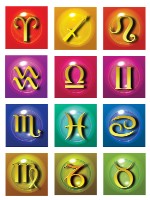Facts About Western Astrology: History Trivia
History Trivia Most of the earliest civilizations practiced some form of star worship in order to understand the natural world or to predict future events. The roots of what we understand as western astrology seem to come from the Sumerians, Babylonians, Chaldeans and Assyrians-in the area of Mesopotamia. From there, the study of astrology spread to India, but most significantly, it was assimilated by the ancient Greeks, becoming the form we recognize today.
Most of the earliest civilizations practiced some form of star worship in order to understand the natural world or to predict future events. The roots of what we understand as western astrology seem to come from the Sumerians, Babylonians, Chaldeans and Assyrians-in the area of Mesopotamia. From there, the study of astrology spread to India, but most significantly, it was assimilated by the ancient Greeks, becoming the form we recognize today.
One of the world’s oldest horoscopes was cast for a baby born on April 29, 410 BC in Mesopotamia. About this time, the culture of this area began to believe that the position of planets and stars at the time of an individual’s birth had a direct impact on the course of that person’s life.
The Greeks and Romans formalized Middle-Eastern astrology with their pantheon of gods who were each associated with planets. Zeus became Jupiter; Ares, Mars; Aphrodite, Venus; Hermes, Mercury; and Kronos, Saturn. Apollo was associated with the sun and Diana with the moon.
Ancient star-gazers studied the stars and observed how they followed a cycle every year. These patterns evolved into the zodiacal cycle used as a means to measure time. Thus, this cycle was broken into recognizable periods and represented by a zodiac sign like the ram (aries), crab (cancer), virgin (virgo) or fish (pisces).
In all, there are twelve zodiacal signs. These signs also became endowed with traits that would add symbolism and meaning to their interpretations. The naturally headstrong ram implied that those born under this sign would also display headstrong traits.
Each zodiac sign is also related to one of four elements: air, water, fire and earth which endow the signs with different meaning. Each of the elements is furthermore associated with a spirit. Gnomes represent earth; undines, water; sylphs, air; and salamanders, fire. More demarcation occurs as each of the signs was thought to govern a particular part of the human body. For instance, the element of air became associated with blood.
The Greco-Egyptian astrologer Ptolemy wrote his astrological treatise in 140 AD grouping more than one thousand stars into forty-eight constellations. He also believed that all the planets revolved around the earth-this would become the prevailing thought pattern until it was disproved by Copernicus in 1544.
Until the birth of Christianity, astrology thrived in much of Europe, the Near East and northern Africa. Even when the Christian emperor Constantine proclaimed astrology “demonic” in 333, it continued to be studied closely in Islamic lands. Arab astrologers worked in observatories at such places as Samarquand and Maragha in Azerbaijan to make significant advances in the field.
Western astrology did not return to popularity again until Nostradamus published his infamous book of prophecies in 1555. He received the patronage of two renowned queens, Elizabeth I and Catherine de Medici.
Nevertheless, the discoveries made by Copernicus, Galileo and Isaac Newton threw astrology into a questionable study and made the field of astronomy acceptable in a scientific light. The discovery of three planets: Uranus (1781), Neptune (1846) and Pluto (1930) cast more doubt on ancient astrological principles.
Despite its shaky scientific basis, astrology was an important governance in the measurement of time. Its annual cycle broken into the seasons is familiar to us today and is a lasting legacy of the earliest star-gazers.
Although today’s calendar is based on the solar calendar instituted by Pope Gregory VIII in 1582, lunar calendars govern many of the world’s major religions. Jewish, Islamic and Hindu calendars rely on the changing phases of the moon to mark passage of time.
Certainly, there were other systems of astrology practiced by the Chinese and the early peoples of the Americas. Hindus and Tibetans also practiced alternative forms of astrology. Still, the horoscopes we read today are based on western astrology that, over time, has evolved a complex system of charts based on hemispheres, houses and aspects that further denote the influence the stars and planets have on our lives.
